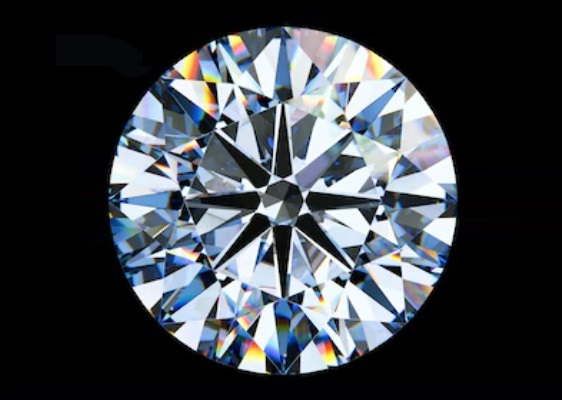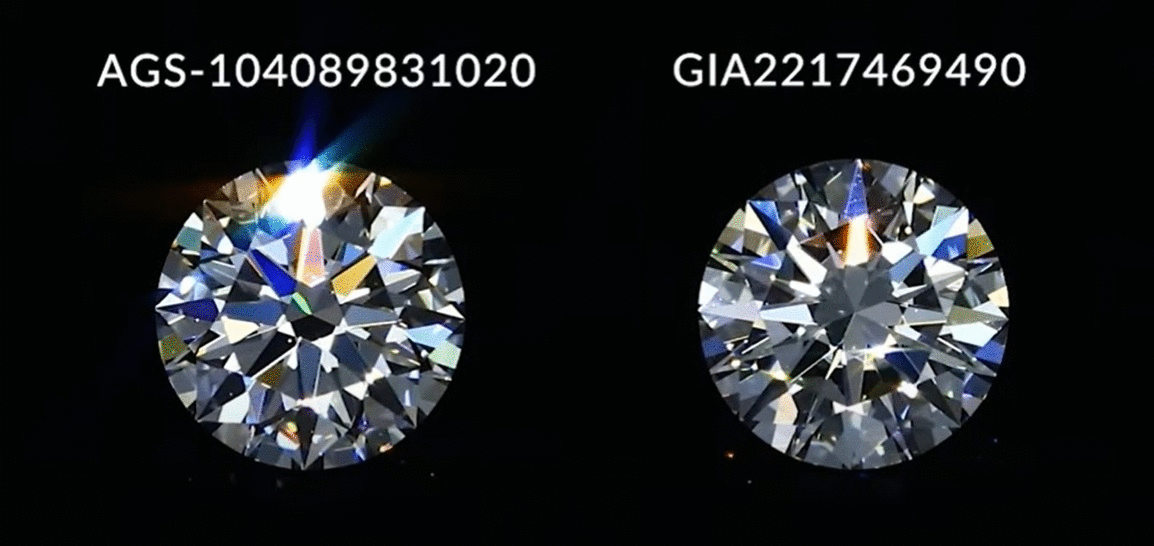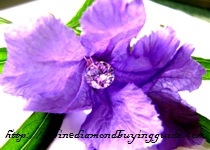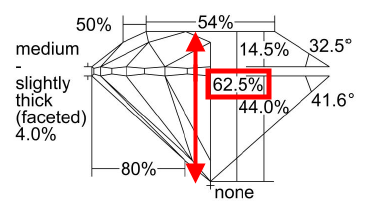What is Diamond Fire (Dispersion) And Why It Matters

Diamond fire dispersion is visually seen as colored flashes of light.
When it comes to diamond rings, cut quality is the most important factor that affects its appearance and gives it the “wow” factor. With better cut quality, a diamond will display better brightness, contrast patterning and fire.
Out of these attributes, fire is often considered the most magical characteristic that turns heads and makes people stop to admire a diamond’s beauty. In this article, we will do a deep dive into understanding what is fire and how it can visually impact a diamond’s appearance.
You can also view videos and comparisons to see how diamond fire looks like in real life. I will also reveal the best places you can shop for a bright, fiery diamond. You ready? Let’s jump right in!
Here is a list of topics we will be covering:
- What Causes Diamond Fire And Light Dispersion?
- How is Diamond Fire Assessed And Graded in the Gemological Labs?
- Why Can’t I See Fire in My Diamond Ring?
- Comparison of Diamond Fire vs Moissanite Fire
- Can Color or Clarity Affect a Diamond’s Fire?
- Where to Buy High Quality Diamonds With The Best Sparkle And Fire
What Causes Diamond Fire And Light Dispersion?

A diamond behaves like a prism which refracts light.
White light is basically made up of many different wavelengths that each correspond to a specific color that our eyes see. From a physics standpoint, the science behind fire occurs when light travels through the diamond and gets refracted.
When light enters the diamond, it is slowed down and bends. Upon hitting the pavilion facets of the diamond, the light reflects back towards the crown facets. As this happens, this causes the light to refract again as it speeds up when exiting the diamond through the crown facets.
Because different wavelengths of light bent at different rates, this refraction causes light to break up into its individual color components and is subsequently seen as fire. If this sounds confusing to you, a simple analogy for this phenomenon is the formation of a rainbow after a rain shower where sunlight is dispersed by water droplets in the atmosphere.
How is Diamond Fire Assessed And Graded in the Gemological Labs?

Comparison of fire between a super ideal cut diamond and a generic triple excellent diamond – WhiteFlash.
In the GIA lab, the fire dispersion of a diamond is graded under LED lighting and a visual assessment is made by a gemologist viewing it at different angles. The brighter and more colored flashes of light seen in the diamond, the better the grade it receives.
In general, the smaller the table facet of a diamond, the more fire the diamond can produce. Fire tends to decrease as table % increases due to a lesser area for crown facets to produce fire. For a round cut diamond, the ideal table size should be between 53-57%.
Now, I want to point out that the table size % shouldn’t be considered in isolation when analyzing a diamond. Besides having a combination of ideal proportions, you need to look at the tangible data of a diamond to correctly assess its light performance.
Why Can’t I See Fire in My Diamond Ring?
This is a commonly asked question I get from readers who are concerned about the “disappearance” of fire and sparkle from their diamond ring. First of all, you need to understand that the light source plays an important role in observing fire.
The facets of a diamond act as a prism to refract light and split it into a spectrum of rainbow colors. A direct, concentrated source of light (e.g. LED) will allow the diamond to disperse it into visual colored flashes of light instead of a large, diffuse source of light (e.g. fluorescent tube).
In the video below, I’ve made a compilation where you can see how 3 diamonds interact with light in different environments. Even though these 3 diamonds all have super ideal cut quality, their performance can be suppressed in an environment with diffused lighting.
Diamond brilliance vs scintillation vs fire seen in different lighting environments.
That’s why jewelry stores often employ high powered halogen lamps in combination with LED and overhead lighting to enhance the diamond’s fire and brilliance. So, if you think that your diamond has “lost its sparkle” after you buy it, the light source is probably the most likely reason why it looks completely different in-store and outside.
Lastly, the light performance of a diamond can be adversely impacted if it is dirty and the facet surfaces have grim on them. When dirt accumulates, it impedes light from entering the diamond and this prevents light from being reflected back into your eyes as brilliance and fire.
Comparison of Diamond Fire vs Moissanite Fire
The beautiful rainbow flashing colors when diamonds disperse light is a reason why many people love them. Moissanite is a gemstone with a double refractive index and this enables it to disperse fire at a higher intensity compared to diamonds.
Because of this phenomenon, many businesses have started marketing moissanite as being a “cheaper”, “better” and “similar” alternative to diamonds. But is moissanite truly comparable to diamonds in terms of its visual appearance?
Watch this video below and let me know what you think.
Most moissanite gemstones are poorly cut because the emphasis is usually on enhancing fire at the expense of brilliance. As a result, most moissanite gemstones in the market are “top heavy” and cut with high crown angles.
This is why most moissanite gemstones in the market look smaller for their carat weight and often display poor contrast patterning and brilliance. And ironically, moissanite has a cheap, oily-looking appearance which gives it a plasticky look because of its refractive index.
If you are looking for a cheaper alternative, I personally think that cubic zirconia (CZ) will be a better option and have a better resemblance to a diamond.
Can Color or Clarity Affect a Diamond’s Fire?
I hesitate to give a blanket answer here because it can be misconstrued by readers. As I’ve mentioned in earlier paragraphs, diamond fire is caused by the dispersion of white light and seen as colored flashes of light return.
If we are talking about colored diamonds like yellow or pink diamonds, then yes, the body color alters the color of light that has entered the stone and subsequently affects the fire that it displays.
For fancy color diamonds, another factor that affects fire is that they are cut to enhance light absorption for stronger color saturation. This is a method that cutters use to achieve more desirable color hues while compromising on the ability of the diamond to disperse fire.
On the other hand, if we are just comparing diamonds on the colorless spectrum like a D color and K color diamond, the color grade differences will not significantly affect the visual appearance of fire.
Also, a diamond’s clarity can affect the fire produced in certain circumstances.
The problematic inclusions that cause a lack of fire are extensive clouds and excessive twinning wisps which are usually found in low SI2 and I1 clarity grades. These types of inclusions will also make the diamond hazy and can be easily avoided by eyeballing the diamond or simply shopping in the higher clarity grades.
Where to Buy High Quality Diamonds With The Best Sparkle And Fire

Diamond fire and brilliance in spot lighting conditions – White Flash listing.
In today’s market, almost everyone can buy diamonds anywhere and there are plenty of retailers to choose from. However, if getting a diamond with the best sparkle and fire is your priority, then the range of options quickly narrows down.
The light performance of a diamond is determined by its cut quality and choosing a truly well cut diamond isn’t as simple as picking a GIA triple-X diamond (excellent grade for cut quality, symmetry and polish). In fact, most GIA triple excellent diamonds have less than ideal cut proportions which result in light leakage and mediocre performance.
If you want a stunning diamond that will exhibit the best brilliance and intense fire, you will need to pay attention to the diamond’s craftsmanship and facet precision. When diamonds are polished to super ideal cut standards, the additional amount of fire and brilliance produced will be easily noticeable compared to generic GIA triple Ex diamonds.
Here is a list of reliable vendors that specialize in super ideal cut diamonds I personally buy from and will recommend:
Whiteflash – A vendor that is well known for their super ideal cut diamonds and has one of the world’s largest inventory for you to cherry pick from. Their cut quality consistency is something that I really love about them. The availability of tangible data to help you assess diamonds in a transparent and objective manner also allows you to shop with 100% confidence.
James Allen – Their Diamond Display Technology allows you to scrutinize and examine each diamond easily in an intuitive manner that is unmatched by any other retailer. James Allen also has a team of experts to handhold you through your shopping process and give you real time advice on any diamond on their website.
Brian Gavin – This 4th generation jeweler has made his name with perfectly cut diamonds that are engineered for the best fire and brilliance. Their Black and Blue signature collections represent less than 0.1% of the world’s highest-performing diamonds. The listings on their website also contain real-life videos of the diamond in different lightings to help you analyze brightness and fire.
With that, I hope you found this article useful and helped you gained a better understanding of fire. If you have further questions or need help with a diamond selection, feel free to leave a comment below or get in touch via email. Good luck!
Related Articles
Leave A Comment














6 Comments
Are brilliance, light performance, fire, scintillation and sparkle referring to the same thing? I’m confused by these terms and they sound the same to me.
In a technical perspective, they do mean different things. Fire is colored light return. Brightness refers to how bright the diamond is and is a result of light entering the diamond and being reflected back into the viewer’s eye. Scintillation is basically the contrast patterning of a diamond where there are patterns of bright and dark areas distributed across the diamond. Ideally, you want contrast patterning to be well defined. Light performance and sparkle simply refer to the overall visual appearance of these 3 factors when you view a diamond.
What diamond cut has the most fire? I’ve heard that old miner cushion diamonds have the best fire while some other people said the round diamond cut.
A well cut old miner diamond will have better fire because of its larger crown facets and higher crown angles it is typically polished to. However, I would have to point out that the modern round brilliant cut looks very different from a vintage style old miner diamond. While it may have better fire, they will look more chunky and exhibit a retro vibe. Most of these old diamonds also tend to have poor symmetry and polish (because of the era in which they are polished). They usually lack the nice contrast patterning and brilliance that a round diamond has. I would make sure you check the type of shape that your recipient likes instead of blindly going after fire.
How do I check the fire of a diamond and brilliance separately when I am in a jewelry store? You mentioned that the lights are placed strategically to enhance them to make them look better but how do I tell the difference from one that will still look good outside the store?
You can ask for tangible data like the ASET or idealscope to have an objective way of analyzing the brilliance of a diamond. For visual inspections, you will need to have some experience in diamond grading to give you a basis of what is good and what isn’t. There’s no way I can teach you this if you haven’t seen BAD diamonds vs the GOOD ones. In the screenshots above, I’ve actually extracted a snippet from White Flash’s videos to show you differences in diamond fire between a super ideal cut diamond and a generic GIA triple excellent stone. For most beginners, they would have assumed that the GIA triple excellent stone would display good fire and simply take someone’s words for it if they were marketing it to you. Yes, the GIA diamond does display good levels of fire but unless you’ve experienced and seen what is truly great, how do you get the benchmark for comparison? If you are looking for diamonds with the best fire, then you need to choose the correct vendors to buy from. Otherwise, stick with tangible data and look at more diamonds to train up your eye.